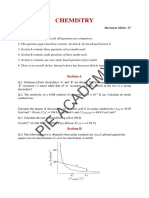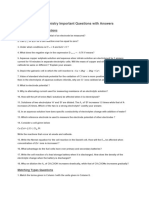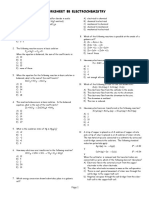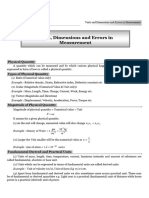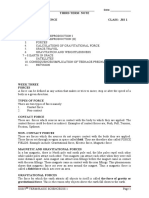0 ratings0% found this document useful (0 votes)
4 viewsELECTROCHEMISTRY mcqs
ELECTROCHEMISTRY mcqs
Uploaded by
kartikyadav2655Copyright:
© All Rights Reserved
Available Formats
Download as DOCX, PDF, TXT or read online from Scribd
ELECTROCHEMISTRY mcqs
ELECTROCHEMISTRY mcqs
Uploaded by
kartikyadav26550 ratings0% found this document useful (0 votes)
4 views5 pagesCopyright
© © All Rights Reserved
Available Formats
DOCX, PDF, TXT or read online from Scribd
Share this document
Did you find this document useful?
Is this content inappropriate?
Copyright:
© All Rights Reserved
Available Formats
Download as DOCX, PDF, TXT or read online from Scribd
Download as docx, pdf, or txt
0 ratings0% found this document useful (0 votes)
4 views5 pagesELECTROCHEMISTRY mcqs
ELECTROCHEMISTRY mcqs
Uploaded by
kartikyadav2655Copyright:
© All Rights Reserved
Available Formats
Download as DOCX, PDF, TXT or read online from Scribd
Download as docx, pdf, or txt
You are on page 1of 5
ELECTROCHEMISTRY
1. An electrochemical cell generally consists of a cathode and an anode. Which of the
following statements is correct with respect to the cathode?
a) Oxidation occurs at the cathode
b) Electrons move into the cathode
c) Usually denoted by a negative sign
d) Is usually made up of insulating material
2. Which of the following is not a generally used electrolyte in the salt bridges used to
connect the two half-cells of an electrochemical cell?
a) NaCl
b) KNO3
c) KCl
d) ZnSO4
3. Which of the following statements is correct regarding Electrochemical cells?
a) Cell potential is an extensive property
b) Cell potential is an intensive property
c) The Gibbs free energy of an electrochemical cell is an intensive property
d) Gibbs free energy is undefined for an electrochemical cell
4. Why are the saturated solutions of electrolytes for the salt bridge prepared in agar-
agar jelly or gelatin?
a) The jelly acts as an electrolyte
b) It helps the electrolytes to mix with the contents of the half cells
c) It helps maintain the electrical polarity between the two half-cell solutions
d) It keeps the electrolyte in semi-solid phase and prevents it from mixing with the
two half-cell solutions
5. What is the direction of flow of electrons in an electrolytic cell?
a) Anode to cathode externally
b) Anode to cathode internally
c) Cathode to anode externally
d) Cathode to anode in the solution
6. Which of the following is a not a secondary cell?
a) Nickel-cadmium cell
b) Lead storage cell
c) Mercury cell
d) Leclanche cell
7. What is the observation when the opposing external applied potential to an
electrochemical cell is greater than the cell’s potential?
a) The electrochemical cell behaves like an electrolytic cell
b) The electrochemical cell stops functioning
c) Only oxidation reactions occur in the cell
d) Only reduction reactions occur in the cell
8. Which of the following conditions are satisfied when the cell reaction in the
electrochemical cell is spontaneous?
a) ΔG° > 0
b) E°cell < 0
c) E°cell = 0
d) ΔG° < 0
9. The values of standard reduction potential of X, Y and Z metals are 0.34 V, 0.80 V
and -0.45 V. Mention their order of strength as reducing agent
(a) Z > Y > X
(b) Z > X > Y
(c) X > Y > Z
(d) Y > Z > X
10. What will be obtained at cathode and anode obtained respectively when electrolysis of
aqueous solution of concentrated NaCl, out between graphite electrodes ?
(a) Cl2 and Na Metal
(b) Cl2 and O2
(c) Cl2 and H2
(d) H2 and Cl2
11. If one mole of electrons are passed through solutions of MgSO4, AgNO3 and AlCl3, In
what mole ratio the metals Mg, Ag and Al will be deposited at electrodes?
(a) 1:1:1
(b) 1:2:3
(c) 2:1:3
(d) 3:6:2
12. The solution of AgNO3 cannot be filled in copper container, why ?
(a) E°AgΙAg+ > E°CuΙCu2+
(b E°CuΙCu2+ > E°AgΙAg+
)
(c) AgNO3 is an acidic solution
(d E°Cu2+ΙCu > E°Ag+ΙAg
)
13. The electricity conducted by 1 mole electron is called _____
(a) 1 Joule
(b) 1 volt
(c) 1 Faraday
(d) 1 coulomb
14. Fe → Fe2+ + 2e-, E°= +0.440 V
Ni → Ni2+ + 2e-, E°= +0.23 V
Cu → Cu2+ + 2e-, E°= -0.345 V
Ag → Ag+ + e-, E°= -0.80 V Which metal will reduced quickly ?
(a) Fe
(b Ni
)
(c) Cu
(d Ag
)
15. How much electricity required to get 1 mole 'Al' from AlCl3 solution?
(a) 3F
(b) 2F
(c) 1F
(d) 3A (ampere)
16. Value of λCH3COONa = 224 ohm-1 cm2 gm equ.-1, λNaCl = 38.2 ohm-1 cm2 gm equ.-
1
and λHCl = 203 ohm-1 cm2 gm equ.-1. Now find the value of λCH3COOH.
(a) 288.5 Ω-1cm2 gm eq-1
(b 289.5 Ω-1cm2 gm eq-1
)
(c) 388.5 Ω-1cm2 gm eq-1
(d 389.5 Ω-1cm2 gm eq-1
)
17. Solutions of two electrolytes X and Y are diluted. Molar conductivity of X increase 25
times whereas that of Y increases 1.5 times. Which one is a stronger electrolyte?
(a) X
(b) Y
(c) Both X and Y
(d) None of the above
18. Which of the following solutions of KCl will have the highest value of specific
conductance?
(a) 0.5 M
(b) 0.01 M
(c) 0.1 M
(d) 1.0 M
19. The electrolyte used in lead storage battery is
(a) Conc. H2SO4
(b) 50% H2SO4
(c) 38 % H2SO4
(d) 5 % H2SO4
20. Which of the following was supplied to anode of a fuel cell used in Apollo space
station?
(a) H2
(b) F2
(c) O2
(d) Cl2
Assertion and reason questions:
Directions: These questions consist of two statements, each printed as Assertion and Reason.
While answering these questions, you are required to choose any one of the following four
responses.
(a) If both Assertion and Reason are correct and the Reason is a correct explanation of the
Assertion.
(b) If both Assertion and Reason are correct but Reason is not a correct explanation of the
Assertion.
(c) If the Assertion is correct but Reason is incorrect.
(d) If both the Assertion and Reason are incorrect.
21. Assertion: Conductivity decreases with dilution.
Reason: The number of ions per unit volume decreases on dilution.
22. Assertion: The resistivity for a substance is its resistance when it is one meter long
and its area of cross-section is one square meter.
Reason: The SI units of resistivity is ohm meter ( m)
23. Assertion: Salts like KCl, KNO3 i.e., inert electrolytes are used in salt bridge.
Reason: An inert electrolyte can easily be filled in the U-tube.
24. Assertion: When the emf of the cell becomes zero, current stops flowing.
Reason: The system of cell reaction attains an equilibrium
25. Assertion: An electrochemical cell can behave like an electrolytic cell when Eext> Ec
el
Reason: When Eext> Ecell, anode start functions as a cathode and cathode as an
Anode
26. Assertion: For measuring resistance of an ionic solution an AC source is used.
Reason: Concentration of ionic solution will change if DC source is used.
27. Assertion: Cu is less reactive than hydrogen.
Reason: E0Cu2+/Cu is negative.
28. Assertion: Λm for weak electrolytes shows a sharp increase when the electrolytic
solution is diluted.
Reason: For weak electrolytes degree of dissociation increases with dilution of
solution.
29. Assertion: Corrosion takes place faster in alkaline medium.
Reason: Aquatic conditions are necessary for the corrosion of iron.
30. Assertion: Electrolysis of aqueous solution of NaCl gives chlorine gas at anode
instead of oxygen.
Reason: Formation of oxygen gas at anode requires overpotential.
Answers:
1. (c)
2. (d)
3. (b)
4. (d)
5. (a)
6. (d)
7. (a)
8. (d)
9. (b)
10. (d)
11. (d)
12. (b)
13. (c)
14. (d)
15. (a)
16. (c)
17. (b)
18. (d)
19. (c)
20. (c)
21. (a)
22. (b)
23. (c)
24. (a)
25. (c)
26. (a)
27. (c)
28. (a)
29. (d)
30. (a)
You might also like
- Principles of Hydrostatics: Unit Pressure or Pressure, PDocument58 pagesPrinciples of Hydrostatics: Unit Pressure or Pressure, PMay Ann ParallagNo ratings yet
- Special Class Electro Chemistry 23Document19 pagesSpecial Class Electro Chemistry 23sheetal10swetaNo ratings yet
- MCQinelectrochemistry 64143Document5 pagesMCQinelectrochemistry 64143Echo borgNo ratings yet
- ElectrochemistryDocument10 pagesElectrochemistryakshitha.s1313No ratings yet
- ELECTROCHEMISTRYDocument4 pagesELECTROCHEMISTRYSAIRAJ PRABHAKAR PAWARNo ratings yet
- Sample Questions - Chapter 15Document6 pagesSample Questions - Chapter 15Rasel IslamNo ratings yet
- Class 12 Electrochemistry QuestionsDocument4 pagesClass 12 Electrochemistry QuestionsShifaNo ratings yet
- XII Chemistry MCQ Test Series 2 2023 2024 1698760736Document4 pagesXII Chemistry MCQ Test Series 2 2023 2024 1698760736bluewheel28No ratings yet
- MCQ On ElectrochemistryDocument8 pagesMCQ On Electrochemistrykashu7183No ratings yet
- Electrochem Question NewDocument9 pagesElectrochem Question NewrjakrithiNo ratings yet
- Electrochemistry AssignmentDocument4 pagesElectrochemistry AssignmentIMMORTAL GAMERNo ratings yet
- ElectrochemistryDocument6 pagesElectrochemistrytwinkleparmar0064No ratings yet
- 12 CBSE competency base questions electrochemistryDocument8 pages12 CBSE competency base questions electrochemistryshashwanth017No ratings yet
- Chapter-Wise Test: Class-XII Chapter-ElectrochemistryDocument2 pagesChapter-Wise Test: Class-XII Chapter-ElectrochemistrySaikat PodderNo ratings yet
- 35 ElectrochemistryDocument5 pages35 Electrochemistryasabarish277No ratings yet
- Electrochemistry PreparatoryDocument4 pagesElectrochemistry Preparatorynithinkumarin2006No ratings yet
- Question Paper ElectrochemistryDocument7 pagesQuestion Paper Electrochemistryvineshuniyal19No ratings yet
- 6d3ba07d3d2eaae13cef7e393704f1acDocument3 pages6d3ba07d3d2eaae13cef7e393704f1acKAPEMBWA MAPALONo ratings yet
- Electro ChemistryDocument7 pagesElectro ChemistryStuti KarnNo ratings yet
- ElectrochemistryDocument17 pagesElectrochemistryzohaibsalamNo ratings yet
- ElectrochemistryDocument2 pagesElectrochemistryKuldeep SharmaNo ratings yet
- 2 QB Electrochemistry24-25Document6 pages2 QB Electrochemistry24-25mailltempp28No ratings yet
- Chemistry - SQP - Unit - ElectrochemistryDocument13 pagesChemistry - SQP - Unit - Electrochemistryitsmekarthik16No ratings yet
- 2 QP ElectrochemistryDocument6 pages2 QP ElectrochemistrysachinNo ratings yet
- ElectrochemistryDocument4 pagesElectrochemistrylsanthijeyNo ratings yet
- ElectrochemistryDocument6 pagesElectrochemistrygangasinghnayal20No ratings yet
- 2.electrochemistry QB (2023-24)Document6 pages2.electrochemistry QB (2023-24)Shana Chandran 18083No ratings yet
- XII Chemistry 7 ElectrochemistryDocument6 pagesXII Chemistry 7 Electrochemistryrajnihemant96No ratings yet
- Work Sheet For G10Document2 pagesWork Sheet For G10Firaol GeremuNo ratings yet
- Eletrochemistry Previous Qns With AnswersDocument8 pagesEletrochemistry Previous Qns With AnswersAkshay SureshNo ratings yet
- Electrochemistry TestDocument3 pagesElectrochemistry TesttusharNo ratings yet
- ELECTROCHEMISTRYDocument5 pagesELECTROCHEMISTRYsarahNo ratings yet
- IMP ElectrochemistryDocument5 pagesIMP ElectrochemistryShan PanwarNo ratings yet
- Electrochemistry Past Papers 2022-14Document4 pagesElectrochemistry Past Papers 2022-1410 A Pratyush Dubey50% (2)
- Electrochemistry Past Papers 2022-14Document4 pagesElectrochemistry Past Papers 2022-14Venugopal JujhavarappuNo ratings yet
- 11 - ElectrochemistryDocument6 pages11 - Electrochemistryhumaaot7No ratings yet
- 2 Electrochemistry24 25Document14 pages2 Electrochemistry24 25uak86070No ratings yet
- 10 FullDocument4 pages10 FullroobanNo ratings yet
- Ncert Exemplar ElectrochemistryDocument26 pagesNcert Exemplar Electrochemistryanshuman18530No ratings yet
- Electrochemical Reactions: + Battery - Salt BridgeDocument7 pagesElectrochemical Reactions: + Battery - Salt BridgewscienceNo ratings yet
- M-CH-2-S-ENGDocument18 pagesM-CH-2-S-ENGrajeevkalota844No ratings yet
- Electrochemistry: E° (Cathode) - E° (Anode) G - nFE F 96,485J/ V X Mols G GDocument15 pagesElectrochemistry: E° (Cathode) - E° (Anode) G - nFE F 96,485J/ V X Mols G GandrewNo ratings yet
- Chemistry ch-3Document19 pagesChemistry ch-3DeekshaNo ratings yet
- CHE1010 Tutorial Sheet 5Document4 pagesCHE1010 Tutorial Sheet 5Chimuka Onson MapikiNo ratings yet
- 3.CBQ ElctrochemDocument7 pages3.CBQ Elctrochemincredibleman653No ratings yet
- Electrochemistry Notes Top ClassDocument13 pagesElectrochemistry Notes Top ClassSriyansh GhoshNo ratings yet
- 12 Electrochemistry Assignment-1Document4 pages12 Electrochemistry Assignment-1Yashraj NarwariyaNo ratings yet
- SUB CHEMISTRY Date27-03-2024Document2 pagesSUB CHEMISTRY Date27-03-2024shankarbannu143No ratings yet
- 3 Electrochemistry Assignment 1Document9 pages3 Electrochemistry Assignment 1Unknown GamerNo ratings yet
- MinrDocument5 pagesMinrrm0518502No ratings yet
- Electrochemistry (1 and 2 Marks QS)Document5 pagesElectrochemistry (1 and 2 Marks QS)Waibhav KumarNo ratings yet
- Che 323 Problem Set 6: Electrochemistry March 12, 2014 Engr. May V. Tampus ConceptsDocument1 pageChe 323 Problem Set 6: Electrochemistry March 12, 2014 Engr. May V. Tampus ConceptsLouie G NavaltaNo ratings yet
- Revision - Electrochemistry (Cbse 2023)Document2 pagesRevision - Electrochemistry (Cbse 2023)Sahana BanuNo ratings yet
- ElectrochemistryDocument5 pagesElectrochemistryDhanush SNo ratings yet
- Electrochemistry 1Document8 pagesElectrochemistry 1radhikase32No ratings yet
- Electro - Thermo-Chemistry Tutorial SheetDocument3 pagesElectro - Thermo-Chemistry Tutorial SheetluganomwanakulaNo ratings yet
- Electrochemistry Question BankDocument11 pagesElectrochemistry Question Bankrranganath305No ratings yet
- Chemistry Descriptive Exam 11.09.2024Document6 pagesChemistry Descriptive Exam 11.09.2024adithyants00No ratings yet
- Unit 8B AP Chem - ElectrochemistryDocument11 pagesUnit 8B AP Chem - ElectrochemistryAnivia12100% (1)
- Sustainable and Green Electrochemical Science and TechnologyFrom EverandSustainable and Green Electrochemical Science and TechnologyNo ratings yet
- Practice Makes Perfect in Chemistry: Oxidation-ReductionFrom EverandPractice Makes Perfect in Chemistry: Oxidation-ReductionRating: 5 out of 5 stars5/5 (1)
- Final-01PE Units, Dimensions and Errors in Measurement - DocDocument10 pagesFinal-01PE Units, Dimensions and Errors in Measurement - Docnavidnazar12028No ratings yet
- Everlight Elec 99 213UMC 384947D TR8 T - C192920Document15 pagesEverlight Elec 99 213UMC 384947D TR8 T - C192920trollkfhNo ratings yet
- Cambridge International AS & A Level: PHYSICS 9702/42Document28 pagesCambridge International AS & A Level: PHYSICS 9702/42abeehawaqas866No ratings yet
- Name: - DateDocument12 pagesName: - DateBlessingNo ratings yet
- Revised B.tech. First Sem Theory +remadial Time Table 2023-24Document17 pagesRevised B.tech. First Sem Theory +remadial Time Table 2023-24Dev KumarNo ratings yet
- Test Report 257 - Aluminium Square Tape Clamp - STC50ADocument18 pagesTest Report 257 - Aluminium Square Tape Clamp - STC50AannamalaiNo ratings yet
- L16 Unsteady State and Reaction EngrDocument25 pagesL16 Unsteady State and Reaction EngrDaniel TemoltzinNo ratings yet
- MSDS For (Dibenzylideneacetone)Document5 pagesMSDS For (Dibenzylideneacetone)Eriko DarmawanNo ratings yet
- Clinical Case in Neurology: Here Is Where Your Presentation BeginsDocument46 pagesClinical Case in Neurology: Here Is Where Your Presentation BeginsMaribelNo ratings yet
- Chemistry NEET 2022 Biomolecules VMC Module: 20 August 1779 Väversunda,, 7 August 1848 (Aged 68), SwedenDocument52 pagesChemistry NEET 2022 Biomolecules VMC Module: 20 August 1779 Väversunda,, 7 August 1848 (Aged 68), SwedenMISHANo ratings yet
- MSDS R134aDocument7 pagesMSDS R134aShanmugam ChandranNo ratings yet
- Final Report BTDocument12 pagesFinal Report BTSANSKAR AGRAWALNo ratings yet
- MirrorsandLensesQuiz 1Document3 pagesMirrorsandLensesQuiz 1eenamorataNo ratings yet
- Era Catalog 2024 2025 Water SupplyDocument10 pagesEra Catalog 2024 2025 Water SupplyrusdiNo ratings yet
- Data and Analysis: Experiment 1: Finding The Density of A Hollow CylinderDocument5 pagesData and Analysis: Experiment 1: Finding The Density of A Hollow CylinderM.S.AbdullahNo ratings yet
- Study of Oxalate Ion Content in Guava FruitsDocument13 pagesStudy of Oxalate Ion Content in Guava FruitsAshish DharNo ratings yet
- Determination of Moisture in Soils by Means of Calcium Carbide Gas Pressure Moisture Tester Fop For Aashto T 217 ScopeDocument3 pagesDetermination of Moisture in Soils by Means of Calcium Carbide Gas Pressure Moisture Tester Fop For Aashto T 217 ScopeMUBARIK AHMAD JANNo ratings yet
- Thermodynamic Analysis of A Lithium Bromide Water Absorption SystemDocument13 pagesThermodynamic Analysis of A Lithium Bromide Water Absorption Systemanon_884382096No ratings yet
- M.Sc. Prev (Physics) PDFDocument6 pagesM.Sc. Prev (Physics) PDFAmit ShuklaNo ratings yet
- NUMS Extra Topics Highlighted SyllabusDocument82 pagesNUMS Extra Topics Highlighted SyllabusTariqNo ratings yet
- Crystal Appearance/Characteristics Clinical SignificanceDocument4 pagesCrystal Appearance/Characteristics Clinical SignificanceAngela LaglivaNo ratings yet
- Dumouchel2008 PDFDocument52 pagesDumouchel2008 PDFMinhaj AkbarNo ratings yet
- Transamination - Wikipedia PDFDocument12 pagesTransamination - Wikipedia PDFkuldeep sainiNo ratings yet
- Radiography Testing Level I and IIDocument7 pagesRadiography Testing Level I and IIJoshnewfound100% (1)
- 6068HF158Document4 pages6068HF158Mohamed AlsindeNo ratings yet
- 8-2 Salt CementDocument23 pages8-2 Salt CementLenin DiazNo ratings yet
- Ship's Hull Theory II, Stability (Module 1)Document17 pagesShip's Hull Theory II, Stability (Module 1)ScarletRahadyanNo ratings yet
- Oxidation and Hot Corrosion: Dr. Ambrish SinghDocument12 pagesOxidation and Hot Corrosion: Dr. Ambrish SinghAmbrish SinghNo ratings yet
- Fiber Optics and Laser Instrumentation - Module 1Document35 pagesFiber Optics and Laser Instrumentation - Module 1maheshnaikm143No ratings yet






























